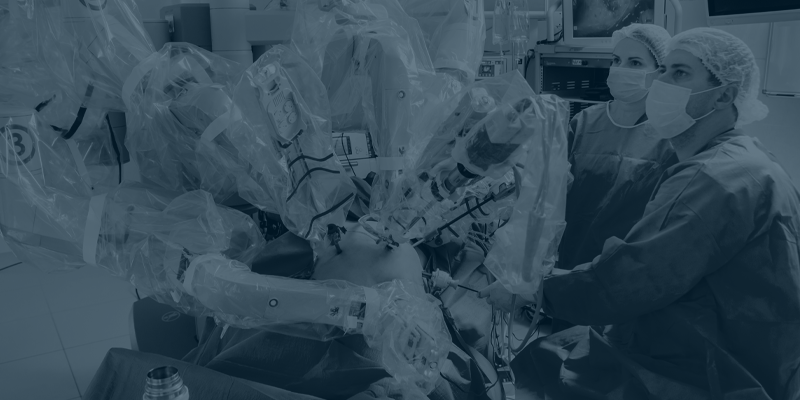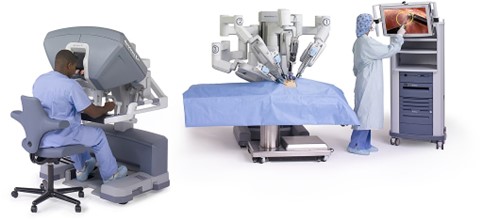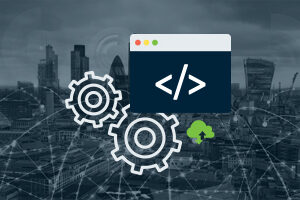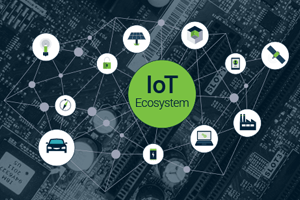If you’ve ever seen the movie Prometheus, you’ll probably remember the scene where Elizabeth just pushes some virtual buttons, lies down, and has her robotic pod perform surgery on her. What about the android personal butler, David, for the elderly character? Those devices don’t exist yet, but the medical industry is definitely making some great advances in that direction.

In this blog, we’ll do a little deep dive into the different types of robotic and artificial intelligence systems that are already being developed. Let’s start with the current state-of-the-art certified robotic systems present in surgery rooms!
How can robots contribute to better healthcare?
Competent medical staff is invaluable for the healthcare system, but specialists are incredibly rare. The expertise scarcity means that a large portion of resources (time, money, fuel) is being spent on transport instead of performing medical procedures (regardless of if the patient or the doctor needs to travel). This is where teleoperated robots can get handy, as only the information (the robot’s real-time motion control) has to travel instead of people physically.
Not to mention that training someone to become a surgeon takes many years and many more years are needed to become a specialist. A computer-based system can be ‘trained’ almost instantly by updating its software: not in the same meaning as training a machine learning model, which can be an extensive process, but with the meaning of deploying an existing model for example. Of course, first, we need the mechanical capabilities and the software stack. That’s something we’re already working on. 😉
Moreover, what are robots best at? Repeating motions over and over again with superhuman precision. Repeating motions over and over again with superhuman precision? Yes, repeating motions over and over again with superhuman precision (author’s attempt at humor). Therefore, the execution mistakes due to ‘human error’ could be significantly reduced. This discussion can be layered and tackled in detail:
- Robots as extensions: teleoperation with full human guidance and control.
- Robots with limited critical autonomy: teleoperation with partial human guidance and control.
- Robots with high critical autonomy: minimal human intervention during the medical procedure.
- Robots with autonomy on non-critical tasks: guiding, servicing and rehabilitation.
- Artificial intelligence enhanced healthcare: from perception and planning for robotics to volumetric registration for medical imaging and biosensors data analysis.
All these systems aim to:
- increase global accessibility of specialized medical expertise
- provide an early potential diagnostic
- optimize time and performance of medical procedures
- improve treatment/rehab consistency by making it fun

Da Vinci Surgical System
Robots as extensions
As mentioned in the introduction, we will discuss the state-of-the-art systems in terms of certified surgical robots. The most popular surgical robot is probably the ‘Da Vinci Surgical System’ (picture above). Although it represents a consistent technological advancement, the system isn’t conceptually complicated overall. In this setup, the robot is an augmentation of the medical practitioner via an optical system and a tactile interface. Basically a screen and a joystick controller (using simple words to describe a rather complex and sophisticated device).
Most of the surgical robots today fall in this class as they’re capable of giving superhuman perception and motion precision abilities to doctors. The teleoperation system acts as a scaling mechanism that can greatly improve the motion accuracy: “if the operator moves a joystick 10 cm, while the surgical robot moves an instrument only 1 cm, then the precision is 10 times increased. And it can be even much more. The optical system offers a focused and immersive connection between the operator and the surgical procedure and it can be further enhanced by augmented reality.
The drawback of these teleoperated surgical robots is that most of them do not have haptic feedback, meaning that the operator doesn’t ‘feel’ resistance when touching the tissue. There’s no force feedback control and therefore the responsibility (and the merit of success) is entirely attributed to the surgeon operating the system. Although they don’t possess substantial autonomy, these medical robots are highly robust and are currently the only type of medical device certified to be used in actual medical procedures.
While being a rather sensitive (and highly confidential) topic, we can proudly say that we have acquired some experience in building demonstrators of robots with autonomy on non-critical tasks, robots with limited critical autonomy, robots with high critical autonomy as well as AI-enhanced healthcare use cases.
Several types of robotics and AI systems are currently already present in healthcare, certified and capable of enhancing surgeons’ skills. However, many technologies and advances are popping up as we speak. In our upcoming blogs, we’ll tackle more types of robotic and artificial intelligence applications in the healthcare field.
Nevertheless, if your curiosity is greater than your patience, don’t hesitate to contact us and pick our brains on what we can do for your medical application!




